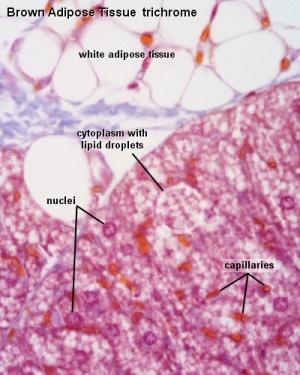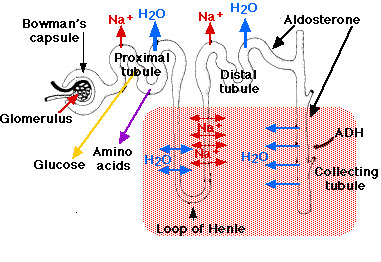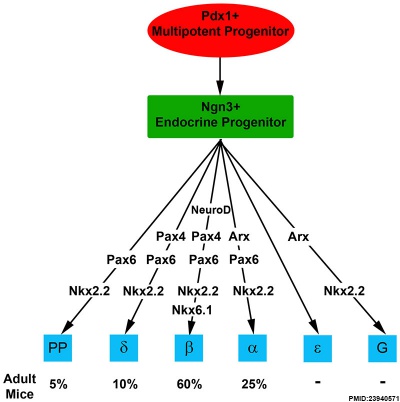Endocrine - Other Tissues
| Embryology - 19 Apr 2024 |
|---|
| Google Translate - select your language from the list shown below (this will open a new external page) |
|
العربية | català | 中文 | 中國傳統的 | français | Deutsche | עִברִית | हिंदी | bahasa Indonesia | italiano | 日本語 | 한국어 | မြန်မာ | Pilipino | Polskie | português | ਪੰਜਾਬੀ ਦੇ | Română | русский | Español | Swahili | Svensk | ไทย | Türkçe | اردو | ייִדיש | Tiếng Việt These external translations are automated and may not be accurate. (More? About Translations) |
Introduction
This current page recognises that there are a growing number of other tissues that have been shown to have a range of associated endocrine functions.
Some Recent Findings
|
| More recent papers |
|---|
|
This table allows an automated computer search of the external PubMed database using the listed "Search term" text link.
More? References | Discussion Page | Journal Searches | 2019 References | 2020 References Search term: Endocrine Embryology | Endocrine Adipose Tissue | Endocrine Heart Tissue | Endocrine Gastrointestinal Tract |Pulmonary Neuroendocrine Cells
|
Endocrine Heart
- Atrial natriuretic peptide (ANP) - Increase Filtration rate / decrease Na+ reabsorption
- Endothelins - ET-1, ET-2, ET-3, Vasoconstriction / Increase NO
- Nitric oxide (NO) - Vasodilatation
Endocrine Lung
Pulmonary Neuroendocrine Cells
| Neonatal Human | Fetal Rabbit |
|---|---|

|
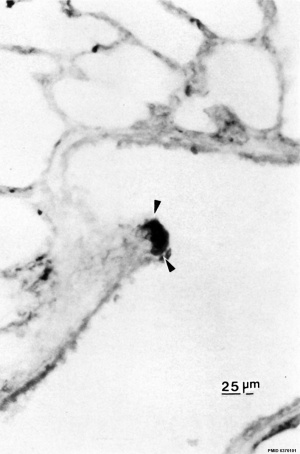
|
| Pulmonary neuroendocrine cell (EM)[2] | Neuroepithelial body[2] |
- Pulmonary Neuroendocrine Cells (PNECs) develop in late embryonic to early fetal period.[3][4]
- first cell type to differentiate in the airway epithelium.
- differentiation regulated by proneural genes - mammalian homolog of the achaete-scute complex (Mash-1) and hairy and enhancer of split1 (Hes-1).[5]
- later in mid-fetal period clusters of these cells form neuroepithelial bodies (NEBs).
- cells migrate to cluster within the epithelium by transient epithelial to mesenchymal transition (EMT)
- located in the fetal lung at bronchiole branching points.
- may stimulate mitosis to increase branching.
- secrete 2 peptides - gastrin-releasing peptide (GRP) and calcitonin gene related peptide (CGRP)
- Gastrin-releasing polypeptide (GRP) is a 27-amino acid neuropeptide, that binds to the GRP receptor a G protein-coupled receptor. GRP is the mammalian equivalent of the amphibian bombesin. Neonatal human lung initial high levels in PNECs then decreases.
- Calcitonin gene-related peptide (CGRP) is a 37-amino acid neuropeptide, that binds to the CGRP receptor and induces increased intracellular cAMP levels.
- in the adult these cells can also be a source for tumourogenesis.
- Links: Respiratory System Development | OMIM - GRP | OMIM - CGRP
Endocrine Kidney
| Kidney Endocrine | ||
|---|---|---|
| Hormone | Function | Comment |
| Renin | increase angiotensin-aldosterone system | paracrine, renin is released by juxtaglomerular cells |
| Prostaglandins | decrease sodium (Na+) reabsorption | paracrine, (PGE2) vasodilator regulate renal vascular reactivity |
| Erythropoietin | increase Erythrocyte production | endocrine, promotes red blood cell formation in bone marrow |
| 1,25 (OH)2 vitamin D | Calcium homeostasis | endocrine, biologically active form of vitamin D |
| Prekallikreins | increase Kinin production | paracrine, act locally to induce vasodilation and contraction of smooth muscle |
- Links: renal | Endocrinology - Chapter 8 Cardiovascular and renal endocrinology | Search PubMed Endocrine Kidney
Gastrointestinal Tract Endocrine
The gastrointestinal tract has its own complex entero-endocrine system (enterohormones) that regulates many regional tract functions.
- Gastrin - Secreted from stomach (G cells), role in control of gastric acid secretion
- Cholecystokinin - small intestine hormone, stimulates secretion of pancreatic enzymes and bile
- Secretin - small intestine hormone (epithelial cells), stimulates secretion of bicarbonate-rich fluids from pancreas and liver
Cells within the stomach express a range of peptide hormones known to regulate a range of gastric functions including secretion of digestive enzymes, mucous and the movement of the luminal contents.
The list below shows the earliest detectible presence of specific hormone-containing cells in regions of the developing human stomach.[6]
- 8 weeks - Gastrin containing cells in stomach antrum. Somatostatin cells in both the antrum and the fundus.
- 10 weeks - Glucagon containing cells in stomach fundus.
- 11 weeks - Serotonin containing cells in both the antrum and the fundus.
Ghrelin
Adult ghrelin is produced in the stomach and acts as a long-term regulator of energy metabolism and as a short-term regulation of feeding.
Prenatally may also have additional developmental and organisational effects.[8]
The developing pancreas also has a population of ghrelin-secreting cells that are not present in the adult, but are also seen expressed in some tumours.
- Links: Gastrointestinal Tract Development | Endocrine Pancreas | Search PubMed Endocrine Gastrointestinal Tract
Adipose Tissue
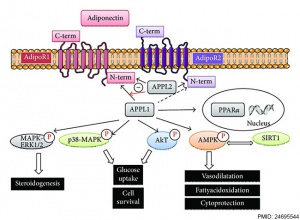
The hormones leptin, adiponectin, and resistin are produced by adipose tissue. Of these hormones, we know the most about leptin, but it too is only a recent discovery (1994) and research has yet to uncover all this molecules hormonal roles. The role of the other listed "adipose hormones" is still even more speculative.[9]
- Leptin - polypeptide hormone produced in adipose and many other tissues with also many different roles
- Adiponectin - regulation of energy homeostasis and glucose and lipid metabolism, as well as acting as an anti-inflammatory on the cellular vascular wall
- Resistin - (for resistance to insulin, RETN) a 108 amino acid polypeptide and the related resistin-like protein-beta (Resistin-like molecule-beta, RELMbeta) stimulate endogenous glucose production
The two forms of adipose are white and brown adipose tissue. Brown adipose is found in newborns (2 - 5 % of the body weight) and can be used to dissipate stored energy as heat (thermogenesis), while adults have mainly white adipose.
Leptin
Leptin was discovered in 1994, named from the Greek word "leptos", meaning thin. This is a polypeptide hormone produced in adipose and many other tissues with also many different roles related to the inhibition of food intake and stimulation of energy expenditure.
In embryology, its levels are associated with fertility and reproductive maturity in many species. There are several additional hormonal roles in the adult including satiety, adiposity, and metabolism.
Leptin has also been shown to be produced by other tissues including the placenta.[10][1]
| Leptin effects on female reproduction | |||
|---|---|---|---|
| Target Tissue | Biological Process | Biological Function | Mechanism |
| Hypothalamus | GnRH secretion | Regulation of LH and FSH secretion | Indirectly via kisspeptin |
| Pituitary | Estrous cycles and ovulation | FSH and LH release; LH plasticity and cyclicity | |
| Ovary | Ovarian steroidogenesis | Estrogen production | P450 aromatase; P450-17α hydroxylase |
| Ovary | Folliculogenesis | Low leptin promotes follicle development | Promotes the transition of primordial to primary follicles |
| Embryo | Embryogenesis | Biophysical effect on embryo growth and quality | Stimulates proliferation |
| Uterus | Angiogenesis | Stimulates metalloproteinase activity | Inhibits terminal differentiation of committed giant cells |
| Table modified from:<pubmed>24908087</pubmed> | |||
- Links: Placenta Development
Adiponectin
Adiponectin (ADIPOQ) a 244 amino acid secretory protein hormone (adipokine) involved in regulation of energy homeostasis and glucose and lipid metabolism, as well as acting as an anti-inflammatory on the vascular wall. Expression in the uterus during early pregnancy suggest that this hormone also has a role in the implantation, blocking the decidualisation process of the uterine stromal cells and preventing further trophoblast invasion.[11]
Suggested adult roles include suppressing the development of atherosclerosis and liver fibrosis and also as acting as an anti-inflammatory hormone.
Links: implantation | placenta | OMIM - Adiponectin | OMIM - Adiponectin Receptor 1 | OMIM - Adiponectin Receptor 2
Resistin
Resistin (for resistance to insulin, RETN) a 108 amino acid polypeptide and the related resistin-like protein-beta (Resistin-like molecule-beta, RELMbeta) stimulate endogenous glucose production. Therefore increased adiposity can cause an insulin resistance, subsequently has a postulated role in fat and gut modulation of hepatic insulin action.
Results from a recent study on vitamin C on resistin levels.
Bo S, Ciccone G, Durazzo M, Gambino R, Massarenti P, Baldi I, Lezo A, Tiozzo E, Pauletto D, Cassader M, Pagano G. Efficacy of antioxidant treatment in reducing resistin serum levels: a randomized study. PLoS Clin Trials. 2007 May 4;2(5):e17.
Antioxidant treatment alteration (reduction) of resistin serum levels.
Gestational Diabetes Mellitus
A recent study has compared the levels of adipose hormones in normal and gestational diabetes mellitus (GDM) complicated pregnancies.[12]
In fetal tissue (placenta, amnion and choriodecidua) for the normal pregnancy they found higher levels of the adipose hormones than in GDM.
In maternal tissues (adipose tissue and skeletal muscle) for the GDM pregnancy women have higher leptin than in normal women.
- Links: Maternal Diabetes
References
- ↑ 1.0 1.1 Herrid M, Palanisamy SK, Ciller UA, Fan R, Moens P, Smart NA & McFarlane JR. (2014). An updated view of leptin on implantation and pregnancy: a review. Physiol Res , 63, 543-57. PMID: 24908087
- ↑ 2.0 2.1 DiAugustine RP & Sonstegard KS. (1984). Neuroendocrinelike (small granule) epithelial cells of the lung. Environ. Health Perspect. , 55, 271-95. PMID: 6376101
- ↑ Cutz E. (1982). Neuroendocrine cells of the lung. An overview of morphologic characteristics and development. Exp. Lung Res. , 3, 185-208. PMID: 6188605
- ↑ Cutz E, Gillan JE & Bryan AC. (1985). Neuroendocrine cells in the developing human lung: morphologic and functional considerations. Pediatr. Pulmonol. , 1, S21-9. PMID: 3906540
- ↑ McGovern S, Pan J, Oliver G, Cutz E & Yeger H. (2010). The role of hypoxia and neurogenic genes (Mash-1 and Prox-1) in the developmental programming and maturation of pulmonary neuroendocrine cells in fetal mouse lung. Lab. Invest. , 90, 180-95. PMID: 20027181 DOI.
- ↑ Stein BA, Buchan AM, Morris J & Polak JM. (1983). The ontogeny of regulatory peptide-containing cells in the human fetal stomach: an immunocytochemical study. J. Histochem. Cytochem. , 31, 1117-25. PMID: 6136542 DOI.
- ↑ Suissa Y, Magenheim J, Stolovich-Rain M, Hija A, Collombat P, Mansouri A, Sussel L, Sosa-Pineda B, McCracken K, Wells JM, Heller RS, Dor Y & Glaser B. (2013). Gastrin: a distinct fate of neurogenin3 positive progenitor cells in the embryonic pancreas. PLoS ONE , 8, e70397. PMID: 23940571 DOI.
- ↑ 8.0 8.1 Reverchon M, Ramé C, Bertoldo M & Dupont J. (2014). Adipokines and the female reproductive tract. Int J Endocrinol , 2014, 232454. PMID: 24695544 DOI.
- ↑ Meier U & Gressner AM. (2004). Endocrine regulation of energy metabolism: review of pathobiochemical and clinical chemical aspects of leptin, ghrelin, adiponectin, and resistin. Clin. Chem. , 50, 1511-25. PMID: 15265818 DOI.
- ↑ Masuzaki H, Ogawa Y, Sagawa N, Hosoda K, Matsumoto T, Mise H, Nishimura H, Yoshimasa Y, Tanaka I, Mori T & Nakao K. (1997). Nonadipose tissue production of leptin: leptin as a novel placenta-derived hormone in humans. Nat. Med. , 3, 1029-33. PMID: 9288733
- ↑ Duval F, Dos Santos E, Moindjie H, Serazin V, Swierkowski-Blanchard N, Vialard F & Dieudonné MN. (2017). Adiponectin limits differentiation and trophoblast invasion in human endometrial cells. J. Mol. Endocrinol. , 59, 285-297. PMID: 28733350 DOI.
- ↑ <pubmed>16135665</pubmed>
Online Textbooks
Reviews
Search PubMed
Search April 2010
- endocrine adipose - All (75) Review (40) Free Full Text (12)
- endocrine heart - All (140) Review (47) Free Full Text (22)
- endocrine kidney - All (128) Review (19) Free Full Text (9)
- endocrine gastrointestinal tract - All (115) Review (32) Free Full Text (13)
Search Pubmed: endocrine adipose | endocrine heart | endocrine kidney | endocrine gastrointestinal tract
Additional Images
Adult Histology
Terms
| Endocrine Terms (expand to view) |
|---|
|
| Other Terms Lists |
|---|
| Terms Lists: ART | Birth | Bone | Cardiovascular | Cell Division | Endocrine | Gastrointestinal | Genital | Genetic | Head | Hearing | Heart | Immune | Integumentary | Neonatal | Neural | Oocyte | Palate | Placenta | Radiation | Renal | Respiratory | Spermatozoa | Statistics | Tooth | Ultrasound | Vision | Historic | Drugs | Glossary |
Glossary Links
- Glossary: A | B | C | D | E | F | G | H | I | J | K | L | M | N | O | P | Q | R | S | T | U | V | W | X | Y | Z | Numbers | Symbols | Term Link
Cite this page: Hill, M.A. (2024, April 19) Embryology Endocrine - Other Tissues. Retrieved from https://embryology.med.unsw.edu.au/embryology/index.php/Endocrine_-_Other_Tissues
- © Dr Mark Hill 2024, UNSW Embryology ISBN: 978 0 7334 2609 4 - UNSW CRICOS Provider Code No. 00098G
